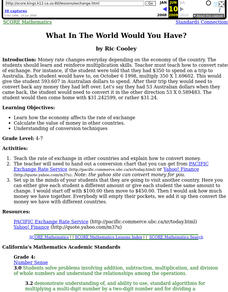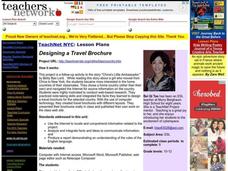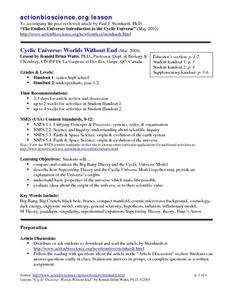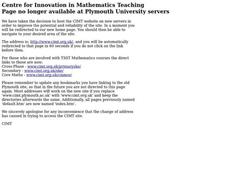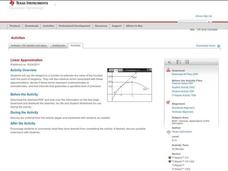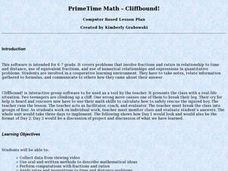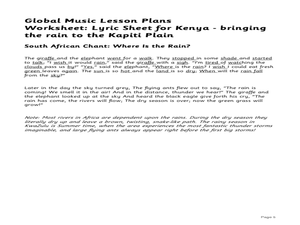Curated OER
Exploring Trigonometric Ratios
Students identify the ratios of trig functions. In this trigonometry instructional activity, students construct triangles and use it to derive the values of sine, cosine and tangent. They use Cabri software to create the visual of the...
Curated OER
What In The World Would You Have?
Students calculate value of money in other countries, and explore how the economy affects the rate of exchange.
Curated OER
Acid Attack
Students explore the effect of chemical erosion on statues and monuments. They use chalk to see what happens when limestone is placed in liquids with different pH values. They also discover several things that engineers are doing to...
Curated OER
Introducing Psychology
Students investigate the concept of observable behavior. They watch someone for three to five minutes and record everything that is seen. Students must be as objective as possible, avoid any value judgments about physical appearance or...
Curated OER
Collecting Data
In this data collection worksheet, students read about how data is collected and organized. They also learn about a hypothesis. Students read through examples of different charts and then answer 23 questions pertaining to data...
Helping with Math
Division: Four Digit by One Digit
Lengthen learners' long division skills with this single-page handout. They must use problem solving skills to find the quotient when a four-digit number is divided by one digit. This is a nice assignment for early in the process of...
Curated OER
Social Life in the 1950's and Domestic Politics and Policy
Eleventh graders examine the cultural mood and politics of the 1950's in the United States. They read a section of their text and take notes, view a clip of the movie "Pleasantville" and discuss societal roles in the 1950's, and listen...
Curated OER
Designing a Travel Brochure
Students discuss a story they had read earlier about a girl moving from China to New York. Using the internet, they research a country other than their own and take notes on the information they collect. They create a travel brochure...
Curated OER
Cyclic Universe: Worlds Without End
Students compare and contrast the Big Bang Theory and the Cyclic Universe Model. They explain basic properties of the univers which make life possible. They evaluate ideas about the origin of the universe as to their scientific value.
Curated OER
Scatter Graphs
In this scatter graphs worksheet, students learn a way of illustrating information about two related values. Students complete 30 questions about the graphs. Note: One of the graphs has English pounds. This is intended as an online...
PBS
The Housing Crisis: GDP, Housing Bubble, Recession
Secondary pupils examine the housing bubble and the 2008 and global economic crisis. Defining GDP and GDP growth, recession, and bubbles, young economists debate what makes a bubble and how housing can be an economic indicator....
Curated OER
Linear Approximation
Pupils practice examining the tangent to a function to estimate the value of the function near the point of tangency. They view errors associated with those approximations, determine overestimates and find intervals that guarantee a...
Curated OER
Country Research
Sixth graders research a given country using teacher selected websites. They gather notes about their country in an organized manner. They then create a PowerPoint including a reference page displaying the information they gathered.
Curated OER
PrimeTime Math: Cliffbound!
Young scholars are involved in a cooperative learning environment that analyzes fractions, ratios to time and distance, equivalent fractions and numerical relationships and expressions in quantitative problems. They take notes, relate...
Curated OER
Listening for Leschi: Voices from the Past
Young scholars interview a family other than their own to learn about oral history. In this oral history lesson plan, students also create a newspaper article about Leschi and pretend they interviewed him back in the past.
Curated OER
Why Use Money? Getting What We Need
Middle schoolers learn the difference between purchase, barter, and payment for service, then explore how the Akan and North African people used a barter system to exchange gold and salt. They identify the most efficient ways of...
Curated OER
Cuisenaire Chefs
Students study the fractional values of Cuisenaire rods while working with favorite family recipes.
Curated OER
Exploring Roman Numerals
Learners construct their own knowledge of Roman numerals by using a Roman numeral calculator on their handhelds. They review the values of Roman numerals. Students explain patterns in Roman numerals, compare and contrast Roman numerals...
Curated OER
Exploring the Renaissance and Reformation
Students examine the effects of the Renaissance and Reformation on Europe. In groups, they use the internet researching their section of the project and take notes of information. They create a visual aid and present their findings to...
Curated OER
Food Safety and Quality Assurance
High schoolers identify and interpret how milk is processed and learn important concepts in food safety and quality assurance. They identify how milk is processed, the importance of food safety, and the quality assurance process....
Curated OER
Body Language
Students practice communication skills. In this body language lesson plan, students compare verbal and nonverbal communication as they analyze body language and learn how it conveys emotions.
Curated OER
Bringing the Rain to the Kapiti Plain - Kenya
Students accompany music to the story Bringing the Rain to the Kapiti Plain - Kenya to show how sound and music can accompany story description. For this music lesson, students learn how to show sound during a story.
Curated OER
Science Journal Writing: Observation, Problem Solving
Students consider the value of keeping a science journal. They make a journal and prepare the first entries.
Curated OER
Practical Writing in the Intermediate Grades
Pupils discuss lists of interesting topics on which to write. They explore those things that interest them, excite them and express themselves freely. They organize the value of their own thoughts and use their individual lists that...

